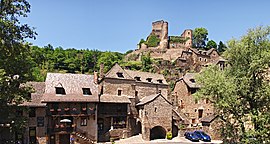|
Belcastel, Aveyron
Belcastel (French pronunciation: [bɛlkastɛl]; Occitan: Bèlcastèl) is a commune in the Aveyron department in the Occitania region in Southern France. The village is medieval in character, with cobbled streets and lauze-roofed (stone tiled) houses. The bulk of the village and the castle (Château de Belcastel) are situated on the steep north bank of the river Aveyron. Several buildings including the 15th-century church are on the south side of the river, with a similarly aged bridge connecting the two. A ruined fort, the Fort du Lourdou, can also be found about a kilometre west of the village on the south bank of the river at the Roc d'Anglars. Belcastel was nominated as one of the "most beautiful villages of France" (Les Plus Beaux Villages de France) in 1990; the local council regularly hosts watercolour competitions and art exhibitions during the summer. Demographics
Gallery
See alsoReferences
External linksWikimedia Commons has media related to Belcastel (Aveyron). |
||||||||||||||||||||||||||||||||||||||||||||||||||||||||||||||||||||||||||||||








